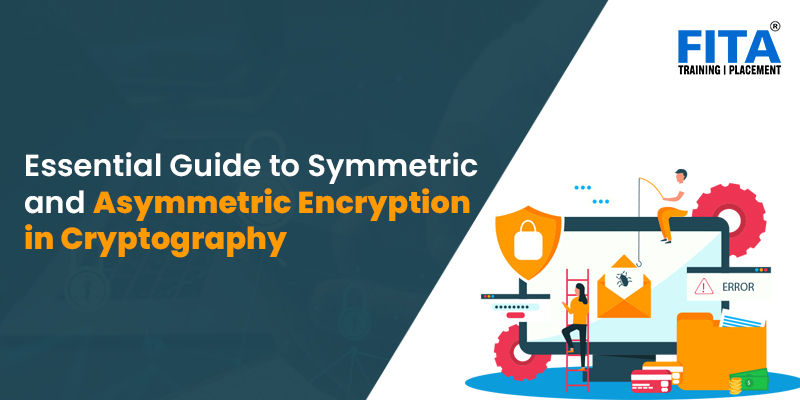
The comparison between symmetric and asymmetric encryption is frequently employed within different types of cryptography and computer security. In symmetric encryption, a single key is used for both data encryption and decryption, whereas asymmetric encryption employs two keys, one public and one private, for these operations. Each encryption method possesses distinct advantages and drawbacks, and the selection between them hinges on the specific requirements of the user. Join the Cyber Security Course in Chennai at FITA Academy and understand about different phishing methods
What is Data Encryption?
Data Encryption is a security process that, when properly understood, can be straightforward to implement. To elucidate the fundamentals of this essential data protection technique, let’s review its core concepts. Encryption, in essence, involves taking a piece of information and converting it into an entirely unrecognisable form, known as ciphertext.
The generation of ciphertext entails running the data to be encrypted through an encryption algorithm. This algorithm, operating based on randomised rules, metamorphoses the original information into an entirely opaque piece of data—a sort of “translation,” if you will.
The encryption algorithm effectively crafts a new language, concealing sensitive information by converting it into this cryptic code, which can only be deciphered and reverted to plaintext if one possesses the requisite rules, also referred to as a key. The key encapsulates the mathematical processes the algorithm employed to transmute your text from something like “Hello World” into something as obscure as “XJtg920kl#aJFJ”%¨FK”. Absent this key, decryption is impossible, rendering the data impervious to unauthorised access. Enrolling in a Data Analytics Course in Chennai will not only equip you with the skills to analyze and interpret data effectively but also provide insights into securing sensitive information through encryption.
Types of Encryption Systems
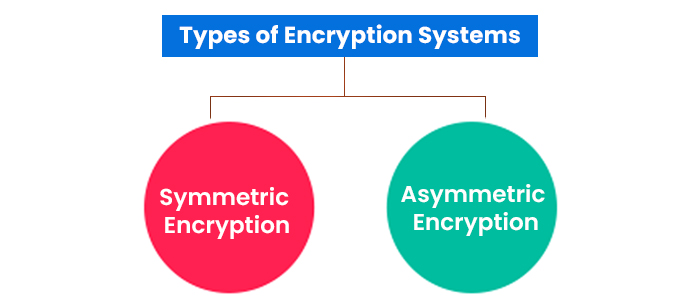
Numerous encryption algorithms and methods are available, but selecting the most secure option for your cyber security analytics requirements can be a critical decision. To make an informed choice, it’s essential to start with an examination of the two primary encryption systems: symmetric and asymmetric encryption.
Symmetric Encryption
Symmetric encryption operates with a single key that all parties involved share to both encrypt and decrypt information. The process is straightforward, as demonstrated in the following example: You use a specific key to encrypt an email and transmit the encrypted email to your friend Tom, and he employs the same symmetric key to unlock and decrypt the message.
What is a Symmetric Key?
A symmetric key is a key that serves the dual purpose of encrypting and decrypting data. This implies that, for data decryption, the same key that was used for encryption must be employed. In practical terms, these keys represent a shared secret that is known to and utilised by two or more individuals to maintain a confidential information channel.
The advantages of symmetric encryption include its swifter performance and lower resource consumption. However, it is worth noting that symmetric encryption is relatively older and less secure compared to its counterpart. The rationale behind this lies in its fundamental principle: when you expand the use of symmetric encryption to a larger organisational scale, you essentially place your trust in a single key that needs to be distributed extensively, potentially posing security risks.
Exploring symmetric encryption examples in everyday technologies
- Symmetric encryption is a widely adopted method for safeguarding data across a multitude of applications, offering confidentiality and integrity assurance. One key is used for both encryption and decryption, which is how efficient it is. Here are three practical examples that highlight the effectiveness of symmetric encryption in modern cyber security:
- Secure Messaging Apps: To secure end-to-end communication encryption, these messaging services use symmetric encryption, such as the Signal Protocol. This guarantees that only the intended recipients possess the ability to decrypt and read the content, enhancing the privacy and security of online communications.
- File Encryption Software (e.g., VeraCrypt, AxCrypt): File encryption software relies on symmetric encryption algorithms like AES to protect sensitive data stored on devices. This ensures that data remains secure even in cases of device loss or theft. By employing symmetric encryption, users can safeguard their files and maintain control over their confidentiality.
If you want to know more about the latest interview question for a cyber security job role, Check out Cyber Security Interview Questions and Answers, which will help you get an insight into the various types of questions and tips.
Asymmetric Encryption
On the other hand, asymmetric encryption was developed to address the drawback of symmetric encryption, which is the requirement to share a single encryption key that is used for both data encryption and decryption.
What is an Asymmetric Key?
Asymmetric keys serve as the foundation of Public Key Infrastructure (PKI), an encryption approach that relies on a pair of keys, each with a distinct purpose: one key for encrypting plaintext and another for decrypting ciphertext. Each key is exclusive to its respective function.
This advanced and more secure encryption method hinges on the utilization of two interconnected keys during the encryption process: the public key, using the public key for decryption and the private key for encryption.
The way these keys work is as follows:
Public Key
The public key is accessible to anyone who needs to encrypt data. However, it cannot be used for the decryption process. To decrypt the information, a secondary key, known as the private key, is required. This design ensures that the private key remains exclusively in the possession of the entity responsible for decrypting the information, maintaining security even as the scope of encryption expands.
Exploring Asymmetric Encryption Examples in Everyday Technology
Asymmetric encryption holds a pivotal position in contemporary cyber security attacks, delivering crucial attributes such as confidentiality, integrity, and authentication within diverse applications. Through the utilisation of public and private key pairs, examples of asymmetric encryption can be identified spanning a variety of industries and technologies. These instances underscore its significance in fortifying the security of digital information. As a versatile encryption technique, it has evolved into an indispensable instrument for the protection of sensitive data and the establishment of secure digital communications.
- Secure Email Communications (e.g., PGP, S/MIME): Secure email communication technologies like Pretty Good Privacy and Secure/Multipurpose Internet Mail Extensions (S/MIME) heavily rely on asymmetric encryption. These protocols employ public and private key pairs to encrypt email content, ensuring that only the designated recipient possessing the correct private key can decrypt and access the message. This method offers both confidentiality and message integrity, enhancing email security.
- Digital Signatures for Document Authenticity and Integrity (e.g., Adobe Sign, DocuSign): Asymmetric encryption is integral to digital signature services like Adobe Sign and DocuSign. When a user digitally signs a document, their private key is employed to create a unique signature. Recipients can subsequently verify the authenticity and integrity of the document by employing the sender’s public key. This process guarantees that the document has not been tampered with and verifies the identity of the signer, bolstering document security and trustworthiness.
- Secure Key Exchange and Establishment in SSL/TLS Protocol for Secure Websites: Asymmetric encryption plays a crucial role in the Secure Sockets Layer (SSL) and Transport Layer Security (TLS) protocols, utilised to secure data transmission between a user’s web browser and a website. During the initial handshake process, asymmetric encryption is employed for the secure exchange of a symmetric encryption key. Subsequently, this symmetric key is used for the encryption and decryption of data throughout the session. This approach combines the security benefits of asymmetric encryption with the efficiency of symmetric encryption, ensuring both secure and swift communication for secure websites and safeguarding user data and privacy.
Enrol Cyber Security Course in Bangalore and start learning about cybersecurity from the fundamentals
Symmetric vs Asymmetric Encryption
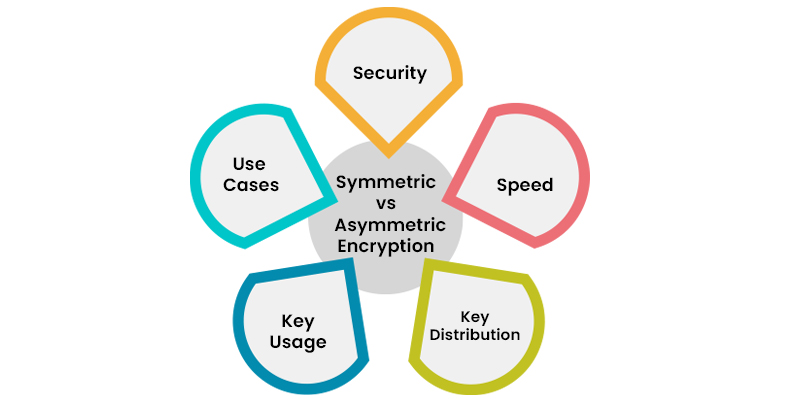
Symmetric and asymmetric encryption are two fundamental techniques for keeping data safe. Let’s simplify it:
Symmetric encryption is like having one special key that can both lock and unlock a treasure chest. It’s fast and works well when you have a lot of stuff to lock up, but you need to make sure that special key doesn’t fall into the wrong hands.
Asymmetric encryption, on the other hand, is like having two keys: one to lock and another completely different one to unlock. The locking key (public key) can be given to anyone, but only the unlocking key (private key) should be kept secret. It’s a bit slower but super secure because even if someone knows the locking key, they can’t open the treasure chest without the unlocking key. To decide which one to use:
Speed
If you need to lock up lots of things quickly, symmetric encryption is faster.
Key Distribution
Symmetric encryption requires careful sharing of the same key. Asymmetric encryption is easier because you only share the locking key.
Key Usage
Symmetric uses one key for both locking and unlocking, while asymmetric uses two different keys for each.
Use Cases
Use symmetric for encrypting lots of data or secure communication in closed systems. Asymmetric is great for secure key exchange, digital signatures, and verifying identity in open systems.
Security
Asymmetric encryption is generally considered more secure because it uses two separate keys, making it harder for attackers. But if you manage the symmetric key well, it can still be very secure.
Selecting The Right Encryption Method For Your Needs
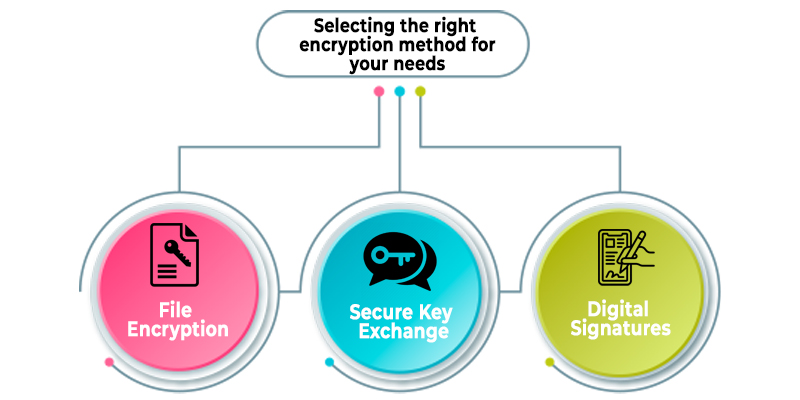
The choice between symmetric and asymmetric encryption hinges on specific security requirements and use cases. Knowing when to apply symmetric vs. asymmetric encryption is pivotal for upholding secure communications and safeguarding sensitive information. Several factors, including key management, computational efficiency, and desired functionality, should guide the selection of the most appropriate encryption method for a given scenario.
Here are three practical examples illustrating when to utilise symmetric and asymmetric encryption:
File Encryption
When it comes to encrypting files, symmetric encryption is the preferred choice. Its speed and computational efficiency make it exceptionally well-suited for handling substantial volumes of data efficiently, ensuring the confidentiality and integrity of files without compromising performance.
Secure Key Exchange
Asymmetric encryption is commonly employed for secure key exchange in protocols like SSL/TLS. This ensures that symmetric keys can be exchanged securely between parties without the risk of interception. The asymmetric encryption’s strength in secure key exchange plays a pivotal role in establishing secure communication channels, particularly over the internet.
Digital Signatures
Asymmetric encryption is a suitable choice for generating digital signatures. It enables users to authenticate documents and verify their integrity using public and private key pairs. This application ensures the authenticity and integrity of digital documents, allowing recipients to confirm the source and integrity of the information they receive. Learn Cyber Security Course in Pune from the fundamentals of cybersecurity
Which Data Encryption Algorithm is Best?
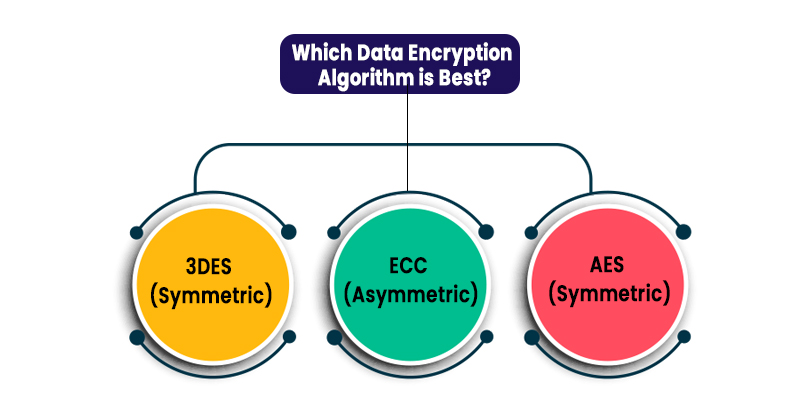
Indeed, the choice of the “best” encryption algorithm depends on specific needs and priorities. Each algorithm has particular advantages and uses. Here’s a summary of their standout qualities:
AES (Symmetric)
AES is widely used due to its speed and the option for variable key lengths, enhancing security. It excels when handling large volumes of encrypted data.
TwoFish (Symmetric – formerly BlowFish): TwoFish offers flexibility in performance, allowing precise control over encryption speed. This adaptability makes it suitable for various scenarios.
3DES (Symmetric)
3DES, despite slower speeds and an older status compared to AES, remains prevalent in financial services for encrypting ATM PINs and UNIX passwords.
RSA (Asymmetric): RSA encryption is primarily used for digital signatures, email encryption, SSL/TLS certificates, and browsers. Its slower speed is well-suited for these specific applications.
ECC (Asymmetric)
ECC combines low cost, minimal resource usage, and high security, making it an ideal choice for safeguarding sensitive mobile devices and applications. It holds promise as a potential algorithm for the future.
The “best” algorithm depends on the context and objectives of the encryption, whether it’s for speed, security, specific applications, or cost-effectiveness.
Encryption stands as a fundamental pillar of modern cyber security, albeit it can initially appear complex due to its multifaceted nature. In today’s data-driven world, the need for safeguarding information, whether it’s data at rest or data in transit, is omnipresent. Therefore, a thoughtful evaluation of access requirements, transmission methods, and the nature of interactions involving sensitive data is imperative. This assessment ensures that appropriate encryption measures are put in place, assuring the confidentiality and integrity of the data.
The scope of encryption can encompass a wide array of scenarios, ranging from safeguarding enterprise communications and web browser data to securing e-commerce transactions, company databases, hard drives, as well as customer and user data. Initiating the process might seem daunting, but it’s essential to begin by documenting all data interactions and devising a comprehensive plan. This approach allows for a clear understanding of the types of encryption required for each specific use case. Join the Cyber Security Course in Mumbai and understand about different types of network security and policies.
Fortunately, there are user-friendly encryption tools readily available to facilitate the implementation of robust data security protocols. For instance, macOS offers FileVault, which is seamlessly integrated and capable of encrypting Mac computers using the AES algorithm. Similarly, for Microsoft computers, tools like Prey can leverage BitLocker and AES for disk encryption, which is especially advantageous for remote workforces. With remote encryption capabilities, these tools relieve the administrative burden while ensuring the safety of company data.
